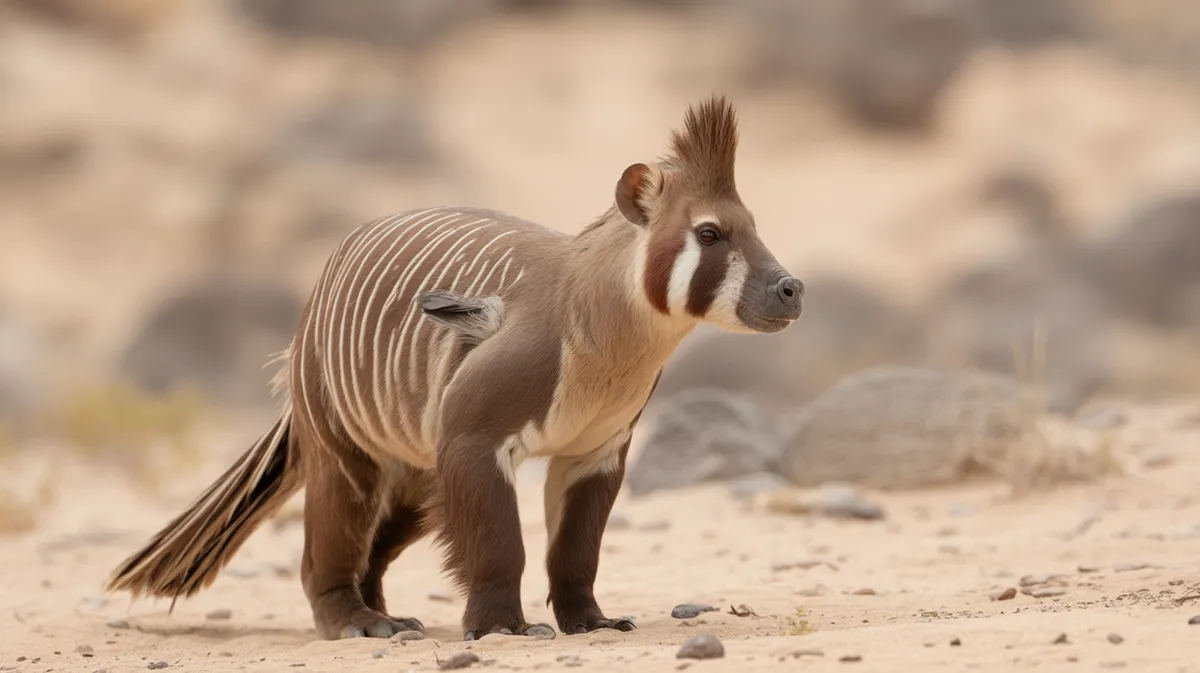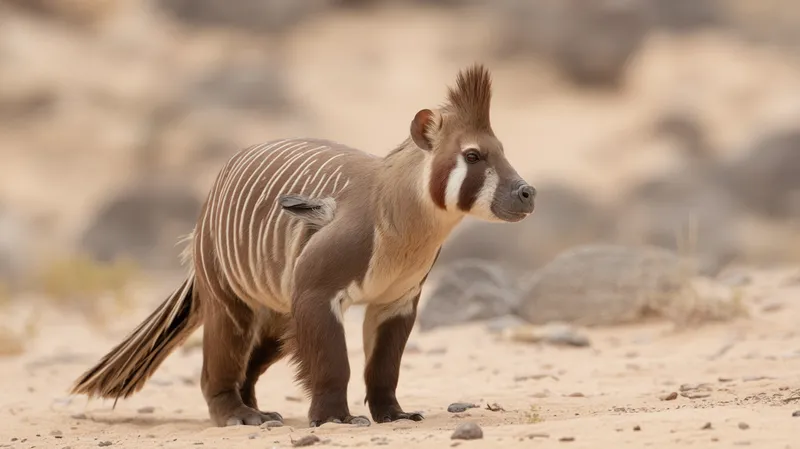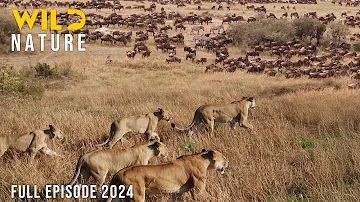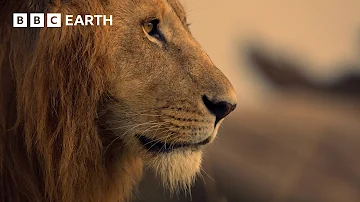
Kowari
Dasyuroides byrnei

Meet the Kowari
The Kowari is a small, carnivorous marsupial native to the arid interior of Australia. Recognizable by its bushy black-tipped tail and pointed snout, the Kowari is an agile nocturnal hunter that preys on insects, spiders, and small vertebrates. It lives in burrows dug in sandy or stony desert habitats, where it avoids the extreme daytime heat. Despite its fierce predatory nature, the Kowari is threatened by habitat degradation, introduced predators, and a limited range. Its unique adaptations make it an important species for understanding the ecology of Australia’s deserts.
Classification
Mammal
Habitat
Arid stony and sandy deserts
Diet
Carnivore
Lifespan
3-5 years
Conservation
Vulnerable
Weight
70-140 grams
📖Fascinating Facts
Desert Specialist
Kowaris are specially adapted to the harsh, dry environments of central Australia's stony and sandy deserts.
Tiny Predator
They have sharp teeth and powerful jaws, enabling them to take down insects, lizards, and even small mammals.
No True Pouch
Unlike many marsupials, female Kowaris lack a true pouch; their young cling to teats on the mother’s belly until old enough to survive in the burrow.
📋Detailed Description
The kowari (Dasyuroides byrnei) is a small, robust marsupial predator, typically weighing between 70 and 160 grams and measuring 16–18 cm in head-body length, with a distinctive bushy, black-tipped tail that adds another 13–15 cm. Its fur is dense and pale grey to fawn, providing camouflage against the stony gibber plains of central Australia. The snout is sharply pointed, and the ears are relatively large, aiding in acute hearing. Kowaris are digitigrade, with well-developed claws for digging and capturing prey. Their eyes are large and forward-facing, reflecting their nocturnal and crepuscular activity patterns. Anatomically, they possess a short, broad skull and powerful jaws relative to their size, allowing them to subdue prey larger than themselves. The species is highly agile and capable of rapid, bounding movements across open terrain. Unlike many marsupials, the kowari lacks a pouch; instead, the young cling to the mother's teats and later ride on her back. The species is solitary outside of the breeding season, occupying complex burrow systems that provide shelter from temperature extremes and predators.
💡 Did you know?
Despite their small size, Kowaris are formidable hunters that can take down prey nearly their own size using their strong jaws and sharp teeth.
🔬Research & Sources
Wikipedia Summary
The kowari, also known by its Diyari name kariri, is a small carnivorous marsupial native to the gibber deserts of central Australia. It is the sole member of the genus Dasyuroides.
Last Modified: 6/8/2025
🎭Behavior & Social Structure
Kowaris are primarily nocturnal, emerging from their burrows at dusk to hunt. They are opportunistic carnivores, preying on insects (such as beetles and grasshoppers), spiders, small reptiles, and occasionally small mammals or birds. Their hunting style is active and agile, involving rapid pursuit and pouncing. Kowaris are known for their boldness and aggression relative to their size, often taking on prey close to their own body mass. They mark their territories with scent glands located near the cloaca and exhibit threat displays when confronted by conspecifics. Social interactions are generally limited to the breeding season, with individuals maintaining exclusive home ranges. During the day, they rest in self-dug burrows or, less commonly, in crevices or under vegetation. Kowaris are also known to cache food in their burrows, a behavior that helps them survive periods of prey scarcity.
👶Reproduction & Life Cycle
Breeding in kowaris typically occurs from May to December, with some regional variation depending on rainfall and resource availability. Females are polyestrous and can produce up to two litters per year under favorable conditions. After a short gestation of about 35 days, females give birth to 6–7 tiny, underdeveloped young, which attach to the teats for approximately 6 weeks. As the species lacks a true pouch, the young are protected by the mother's fur and later ride on her back. Weaning occurs at around 10–13 weeks, and juveniles become independent shortly thereafter. Sexual maturity is reached at about 10–11 months. Parental care is provided solely by the female, with males playing no role after mating. Litter size and juvenile survival are closely linked to environmental conditions, particularly food availability.
🛡️Adaptations & Survival
Kowaris exhibit several key adaptations for desert life. Their dense fur insulates against both cold nights and hot days, while their burrowing behavior allows them to escape extreme surface temperatures. They have highly efficient kidneys, producing concentrated urine to minimize water loss—a crucial adaptation for arid environments. Their keen senses of hearing and smell aid in locating prey in the sparse desert landscape. The bushy tail may serve as a fat storage organ and as a visual signal during social interactions. Behaviorally, their nocturnal activity reduces exposure to predators and heat stress. Their aggressive temperament and strong bite force allow them to exploit a wide range of prey, giving them a competitive edge in a resource-poor environment.
📚Research Sources
🎨Cultural Significance
The kowari is known by several Indigenous names, including 'kariri' in the Diyari language. It holds some cultural significance for Aboriginal peoples of the Lake Eyre Basin, featuring in local ecological knowledge and traditional stories. However, it is not widely represented in broader Australian folklore or mythology. There is no evidence of historical use as a food source or for other traditional purposes, likely due to its small size and elusive nature.
🔬Recent Research & Discoveries
Recent research on the kowari has focused on its ecology, population genetics, and responses to environmental change. Studies using camera traps and radio telemetry have provided new insights into home range size, movement patterns, and habitat preferences. Genetic analyses suggest low genetic diversity, raising concerns about long-term viability. Ongoing research is investigating the impacts of introduced predators and the effectiveness of targeted management actions, such as predator control and habitat restoration. The kowari is also used as a model species for understanding the adaptations of small marsupial carnivores to arid environments. Conservation programs are increasingly incorporating Indigenous ecological knowledge to inform management strategies.
🎥Wildlife Videos

Wildlife - The Fascinating World of Wild Animals | Full Series | Free Documentary Nature
Wildlife - The Fascinating World of Wild Animals | Wildlife Documentary Watch 'Ocean Stories - Full Series' here: ...
Free Documentary - Nature

WILD OKAVANGO | The Survival Struggles in Africa’s Last Paradise | Animal documentary
WILD OKAVANGO | The Survival Struggles in Africa's Last Paradise Welcome to WILD OKAVANGO, where the magical mysteries ...
WILD NATURE - Nature animal documentary

WILD SERENGETI | Battle for Survival in Predator Territory | Animal documentary
Step into the untamed world of the Serengeti, a sprawling savanna where every moment is a fight for survival. In this gripping ...
WILD NATURE - Nature animal documentary

WILD SAVANNAH | Survival Stories from the Heart of Africa | Animal documentary
Welcome to "WILD SAVANNAH | Survival Stories from the Heart of Africa," an immersive wildlife documentary that plunges you ...
WILD NATURE - Nature animal documentary

An Adventure Through Africa in 4K | BBC Earth
Go on your very own wildlife safari, and experience the incredible animals of Africa in stunning 4K UHD. Watch as lions take down ...
BBC Earth

WILD KRUGER | Survival in The Wild Heart of South Africa | Animal documentary
WILD KRUGER | Survival in The Wild Heart of South Africa Welcome to an exciting journey through Kruger National Park – one of ...
WILD NATURE - Nature animal documentary
🌍Habitat Information
The Kowari typically inhabits Arid stony and sandy deserts environments. Kowaris have adapted to their environments with specialized features and behaviors.
Primary Habitat:
Arid stony and sandy deserts
More detailed habitat information will be available soon.
🛡️Conservation Status
The Kowari is currently classified as Vulnerable. Conservation efforts are crucial for preserving this species for future generations.
Common Threats:
- 🏠Habitat loss and fragmentation
- 🌡️Climate change impacts
- 🎯Hunting and poaching
- 🏭Human-wildlife conflict
⚠️Threats & Conservation Challenges
The kowari is currently classified as Vulnerable by the IUCN, with population declines attributed to several factors. Habitat degradation from overgrazing by livestock and feral animals (especially cattle and camels) has reduced the availability of suitable burrowing sites and prey. Predation by introduced species such as red foxes (Vulpes vulpes) and feral cats (Felis catus) poses a significant threat. Fragmentation of habitat due to infrastructure development and altered fire regimes further exacerbates population isolation. Climate change may also impact prey availability and increase the frequency of extreme weather events. Current population estimates suggest fewer than 10,000 mature individuals, with populations fragmented and declining in range.
🔬Scientific Classification
Scientific Name
Dasyuroides byrnei
Classification Hierarchy
🔍 About Taxonomic Classification
Taxonomic classification is a hierarchical system used by scientists to classify and organize living organisms based on shared characteristics and evolutionary relationships.
The system moves from broad categories (Kingdom) to increasingly specific ones, with each animal's scientific name typically consisting of its Genus and species.
📝Community Notes
Share your observations and insights about the Kowari with our community of wildlife enthusiasts.
Join Our Community
Sign in to share your observations and connect with fellow wildlife enthusiasts.
Sign In to ContributeNo community notes yet
Be the first to share your observations about the Kowari!
Explore Kowari
Select a tab above to learn more about this amazing animal.
📸Photo Gallery
No photos available for this animal yet.
🌟Discover More Wildlife
Continue your journey of discovery with more fascinating animals from our database
